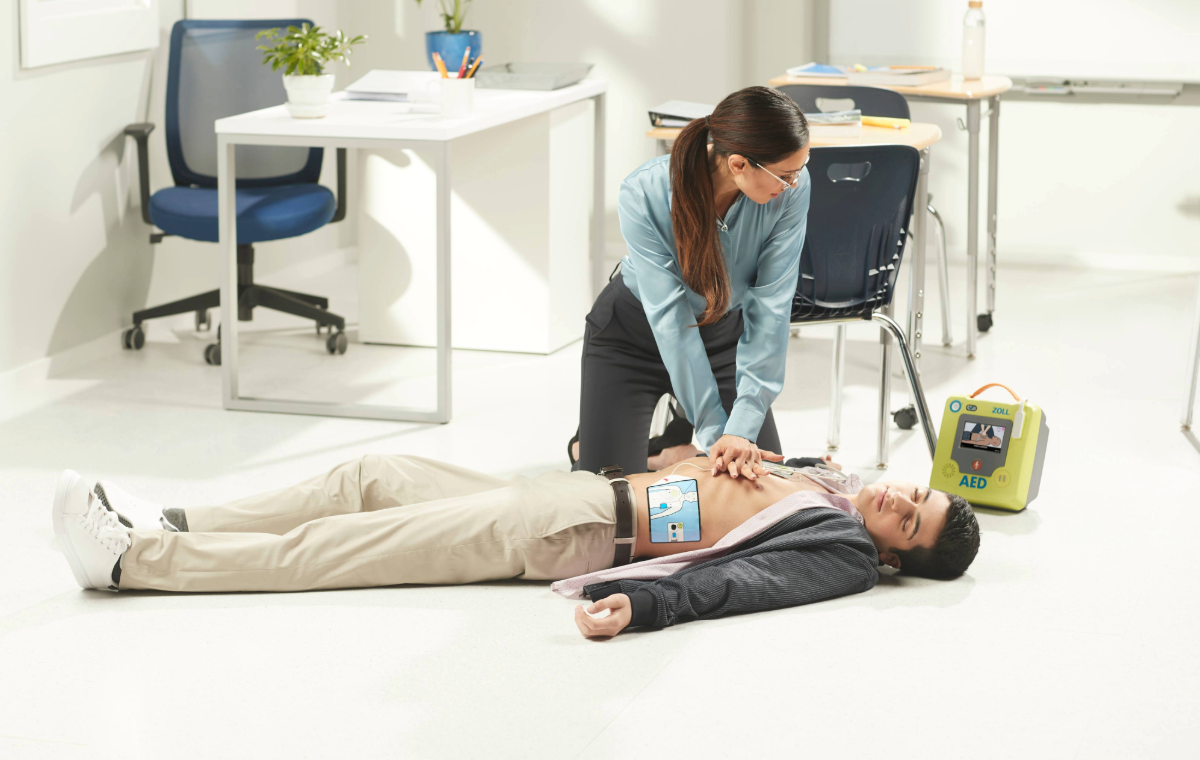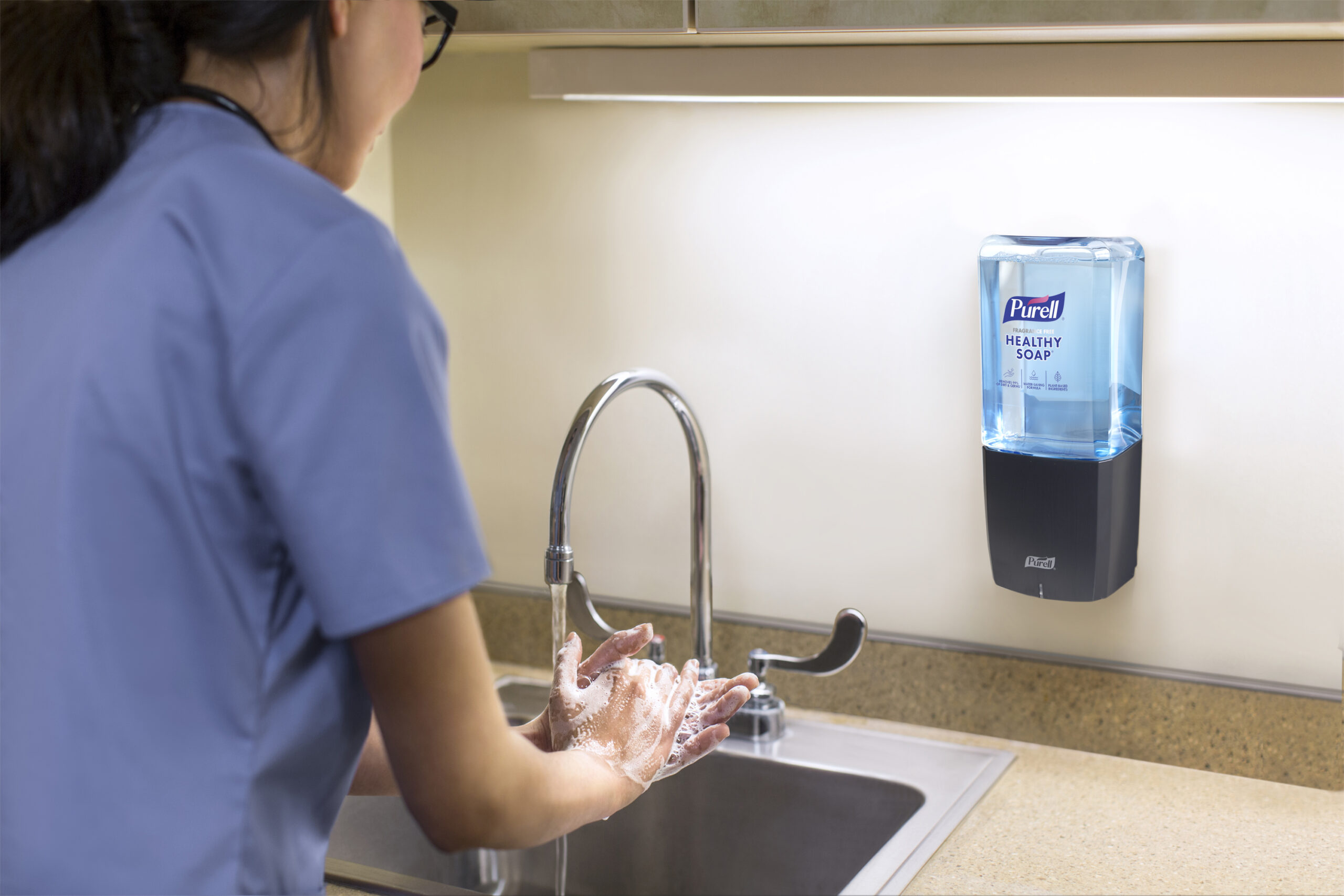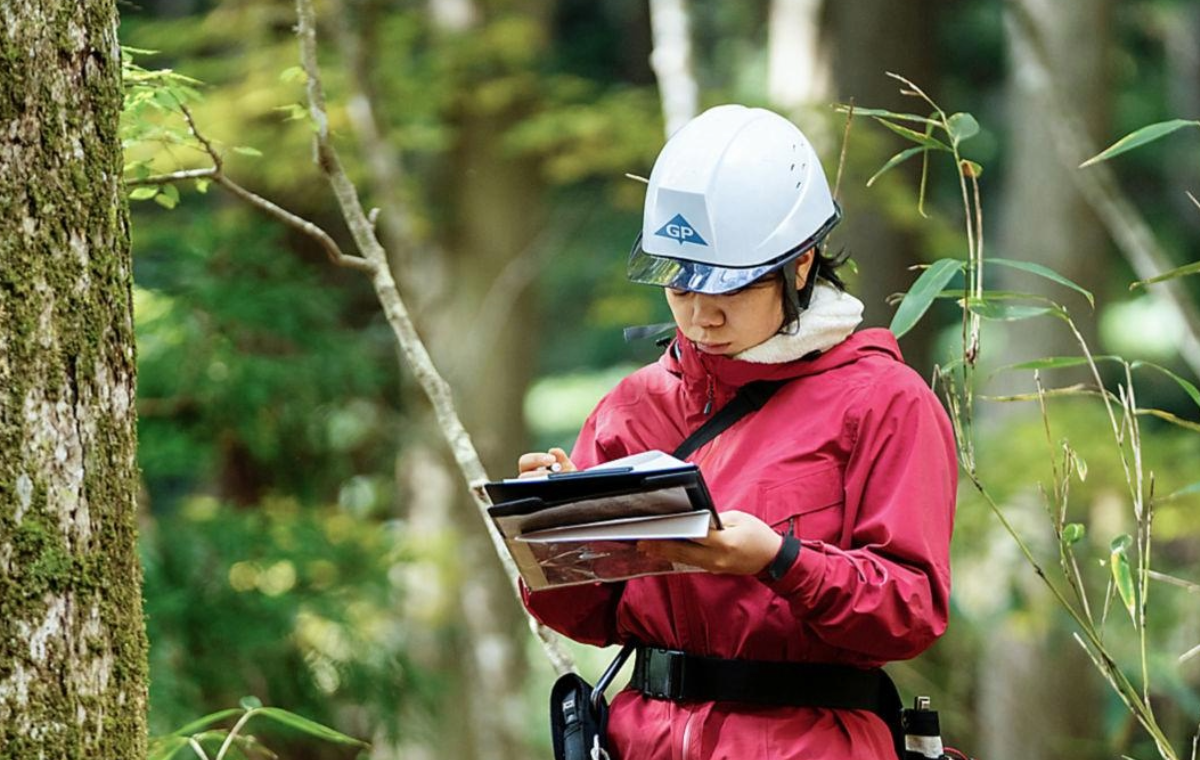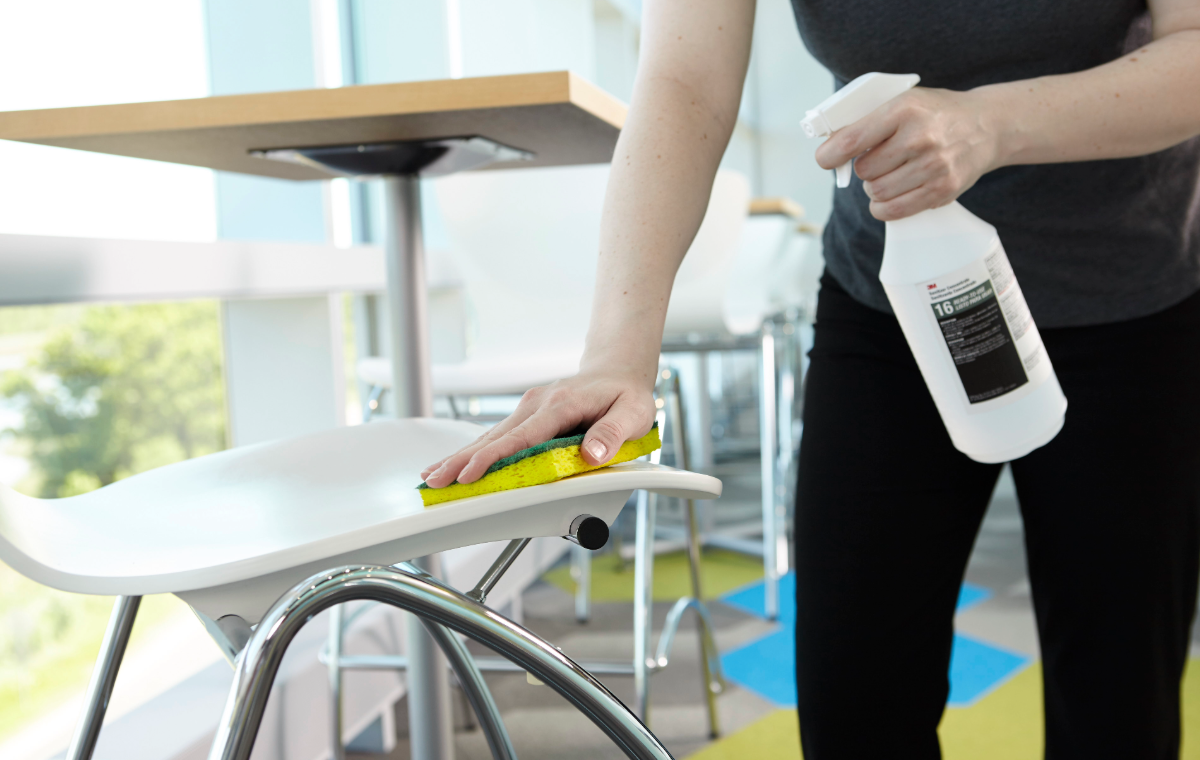June 1-7 is CPR & AED Awareness Week. Sudden cardiac arrest (SCA) can happen to anyone, anytime – including during a normal school day. In fact, more than 7,000 youth under the age of 18 experience sudden cardiac arrest each year in the U.S.1 That’s why it is critical for schools to implement a comprehensive AED program.
Proper SCA education and tools like an automated external defibrillator empower employees to respond to SCA – because minutes count. For every minute that defibrillation is delayed, survival rates plummet by 10 percent.2 Since EMS teams take an average of seven to fourteen minutes to arrive, it’s vital that schools are equipped with tools and training that enable bystanders to intervene immediately.3

AED placement is vital. Each automated external defibrillator (AED) should be placed so anyone can easily find it and respond to the victim quickly. It is recommended that AEDs be located within 3 minutes of each other in any facility or building and near trained users. It’s also important to install clear signage and ensure that AEDs are easy to find. Place AEDs in populated areas including break rooms and cafeterias, as well as in high-risk areas like athletic facilities. It may be necessary to conduct an on-site assessment to ensure the campus is equipped for the best possible outcome.
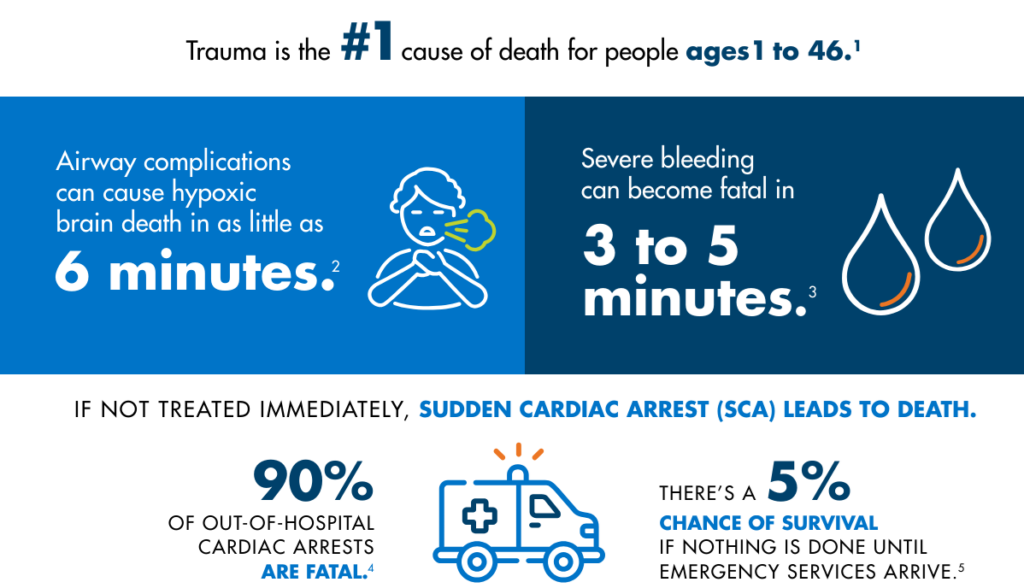
Many people are uncertain about factors such as ease of use, cost, and maintenance. AEDs are proven to save lives, and having one available could mean the difference between life and death. When someone experiences SCA, early defibrillation from an AED is crucial: According to the American Heart Association, survival rates are highest with early defibrillation. Delivering a shock within three to four minutes of an SCA victim’s collapse can increase their chance of survival by 60%.4
A Young Life Saved Thanks to Teamwork and an AED
One warm spring day, Steel Martell, a 7th grader at Sheckler Elementary in Catasauqua, Pennsylvania, suffered sudden cardiac arrest while playing kickball. The school nurse, Jennifer Churetta, heard the call come over the walkie talkie from gym teacher Emily DeOliveira (“Mrs. Deo” to her students). “Mrs. Deo’s voice and something in my gut told me things were very wrong,” Jennifer says. Arriving at the field a few minutes later and finding no pulse, Jennifer immediately began CPR and sent someone to retrieve the AED. She connected Steel to the ZOLL AED Plus®*, which analyzed Steel’s heart and immediately recommended a shock. Rescuers took turns continuing compressions and after a second shock, just as suddenly as he’d collapsed, Steel startled and groaned.

He and his parents are grateful for the immediate, coordinated response of the staff, most of whom had never used an AED outside of annual training.
Without early defibrillation, Steel may not have survived the SCA, but luckily the school district is equipped with lifesaving AEDs.

7 Factors to Consider When Choosing a ZOLL AED
- Value
Look beyond the price tag. Less-expensive AEDs may require more frequent maintenance and replacement of consumables, which increases costs over the life of the AED. The ZOLL AED 3* offers intuitive, comprehensive support for rescuers.
- Feedback
ZOLL AEDs offer best-in-class guidance for rescuers to deliver chest compressions that meet recognized guidelines and recommendations. Studies show that a victim of cardiac arrest is more than twice as likely to survive when rescued with a defibrillator equipped with real-time CPR feedback.5 Understanding CPR quality, including how deep and how fast CPR compressions should be, is a key part of AED/CPR training.
- Support
The ZOLL AED 3® supports rescuers with or without training, by providing Real CPR Help® feedback including easy-to-understand voice and text prompts, and graphics to guide rescuers in performing high-quality CPR throughout the rescue.
- Readiness
Automatic self-testing of internal circuitry, battery, and pads ensures that your AED will be ready at a moment’s notice. ZOLL AEDs feature highly visible readiness indicators, perform regular comprehensive self-tests, and include Wi-Fi functionality for reporting status updates, enabling easy management of large fleets of AEDs. ZOLL’s Rescue Ready Services program management provides a full-service offering, ensuring the ZOLL AED ready and compliant when it’s needed most. That means ensuring faculty is trained to respond, the school campus is compliant with state regulations, and the school nurse is immediately alerted when any aspect of your AED program requires attention. After all, someone’s life depends on it.
- Pad Life
Electrode pads adhere directly to an SCA victim’s chest and are critical to delivering a shock to the heart. Most pads expire and require replacement every 18-30 months; ZOLL AED 3 pads last 5 years.
- Battery Life
The ZOLL AED 3 battery life is 5 years in standby mode. That means fewer replacements, less maintenance, and a low total cost of ownership. Most AED batteries need to be replaced every 2 to 5 years.
- Pediatric Use
Unique, integrated pediatric support treats adult and pediatric patients with a single CPR Uni-Padz®* electrode. Activate child mode (and use the same set of pads) for a pediatric rescue. AEDs with pediatric pads automatically adjust the amount of energy used to defibrillate younger victims. The ZOLL AED 3 is perfect for schools, daycares, or other workplaces where children under the age of eight are present, consider investing in an AED with pediatric capability.
This content was provided by ZOLL Medical Corporation.
*These items are part of our Special Order Catalog and may have varying shipping times
1 American Heart Association Heart Disease and Stroke Statistics- 2018 Update, Published online in Circulation, Jan. 31, 2018
2 Weisfeldt ML, Sitlani CM, Ornato JP, et al. Survival after application of automated external defibrillators before arrival of the emergency medical system: Evaluation in the Resuscitation outcomes consortium population of 21 million. J Am Coll Cardiol.2010;55(16): 1,713-1,720.
3 Mell HK, et al. JAMA Surg. 2017 Oct;152:10:983–984. doi: 10.1001/jamasurg.2017.2230.
4 American Heart Association in collaboration with International Liaison Committee on Resuscitation. Guidelines 2000 for Cardiopulmonary Resuscitation and Emergency Cardiovascular Care: International Consensus on Science, Part 4: The Automated External Defibrillator. Circulation. 2000; Vol. 102, Supplement: I 61. Figure 1.



